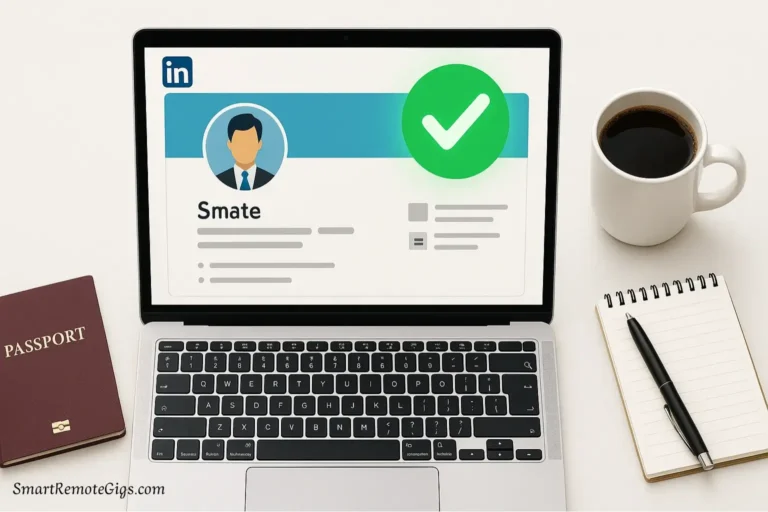Staring at a blank screen, cursor blinking mockingly as you wonder what to post next? You’re not alone. The dreaded “blank page syndrome” paralyzes countless professionals who know they should be creating content but have no idea what to say. You understand that building a strong personal brand content strategy is crucial for career growth, yet the endless question of “what should I post?” keeps you stuck in creative limbo.
Here’s the truth: You don’t need to be a marketing genius or have groundbreaking insights every single day. What you need is a simple, repeatable framework that removes the guesswork forever. This comprehensive guide will walk you through a proven system that transforms content creation from overwhelming to effortless, helping you build authentic thought leadership content that resonates with your audience and advances your career.
Whether you’re a developer, consultant, or executive, this framework works for any industry and any level of expertise. By the end of this article, you’ll have a clear roadmap for consistent, engaging content that positions you as a trusted authority in your field.
Step 1: Define Your “Content Pillars”
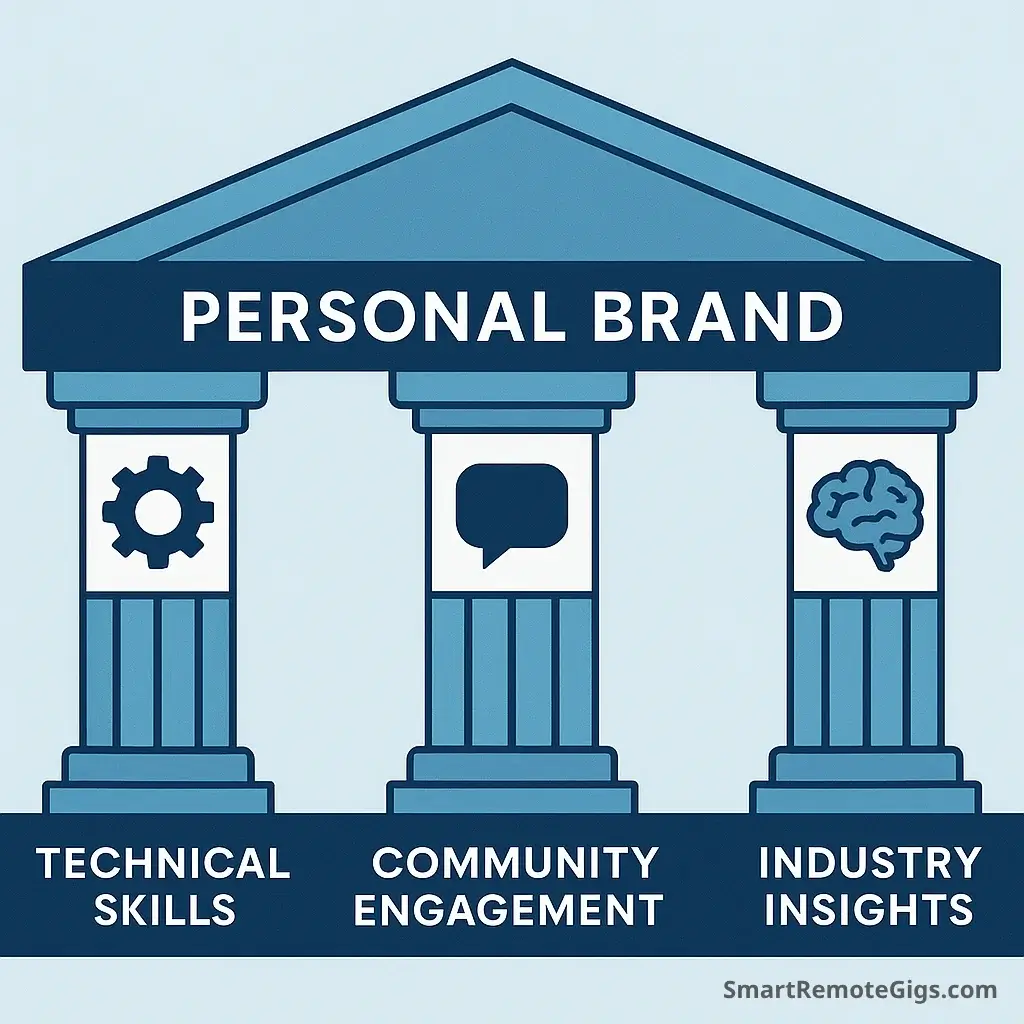
The foundation of any successful personal brand content strategy starts with identifying your content pillars—the 3-5 core topics that will serve as the backbone of everything you create. Think of these pillars as the main themes that define your expertise and value proposition.
Why Content Pillars Matter
Content pillars provide structure and focus to your content creation process. Instead of scrambling for random topics each day, you’ll have a clear framework that ensures every piece of content serves a strategic purpose. This approach also helps you build consistent authority around specific themes, making you the go-to person for those topics in your network.
How to Choose Your Content Pillars
Your content pillars should emerge from the intersection of three key factors:
1. Your Expertise: What do you know better than most people? This could be technical skills, industry knowledge, or specialized experience you’ve gained throughout your career.
2. Your Audience’s Needs: What challenges does your target audience face? What questions do they ask repeatedly? What keeps them up at night?
3. Your Career Goals: Where do you want to be in 2-3 years? What reputation do you want to build? What opportunities do you want to attract?
Example Content Pillar Framework
Here’s how a remote software developer might structure their content pillars:
Pillar | Focus Area | Content Examples |
|---|---|---|
Technical Expertise | Coding best practices, new technologies | Tutorial posts, code reviews, tool comparisons |
Remote Work Mastery | Productivity, collaboration, work-life balance | Tips for distributed teams, home office setups |
Career Development | Professional growth, learning strategies | Skill-building advice, certification journeys |
Industry Insights | Trends, predictions, analysis | Market observations, technology forecasts |
Personal Journey | Challenges, wins, lessons learned | Behind-the-scenes stories, failure analyses |
Validation Exercise
Before finalizing your pillars, test them with this simple exercise:
- Can you easily come up with 10 content ideas personal brand topics for each pillar?
- Do your pillars align with what you want to be known for professionally?
- Would your target audience find each pillar valuable and relevant?
- Do your pillars differentiate you from others in your space?
If you answered “yes” to all these questions, you’ve found your content pillars. If not, refine them until they pass this validation test.
Step 2: The 3-E Formula (Educate, Engage, Entertain)
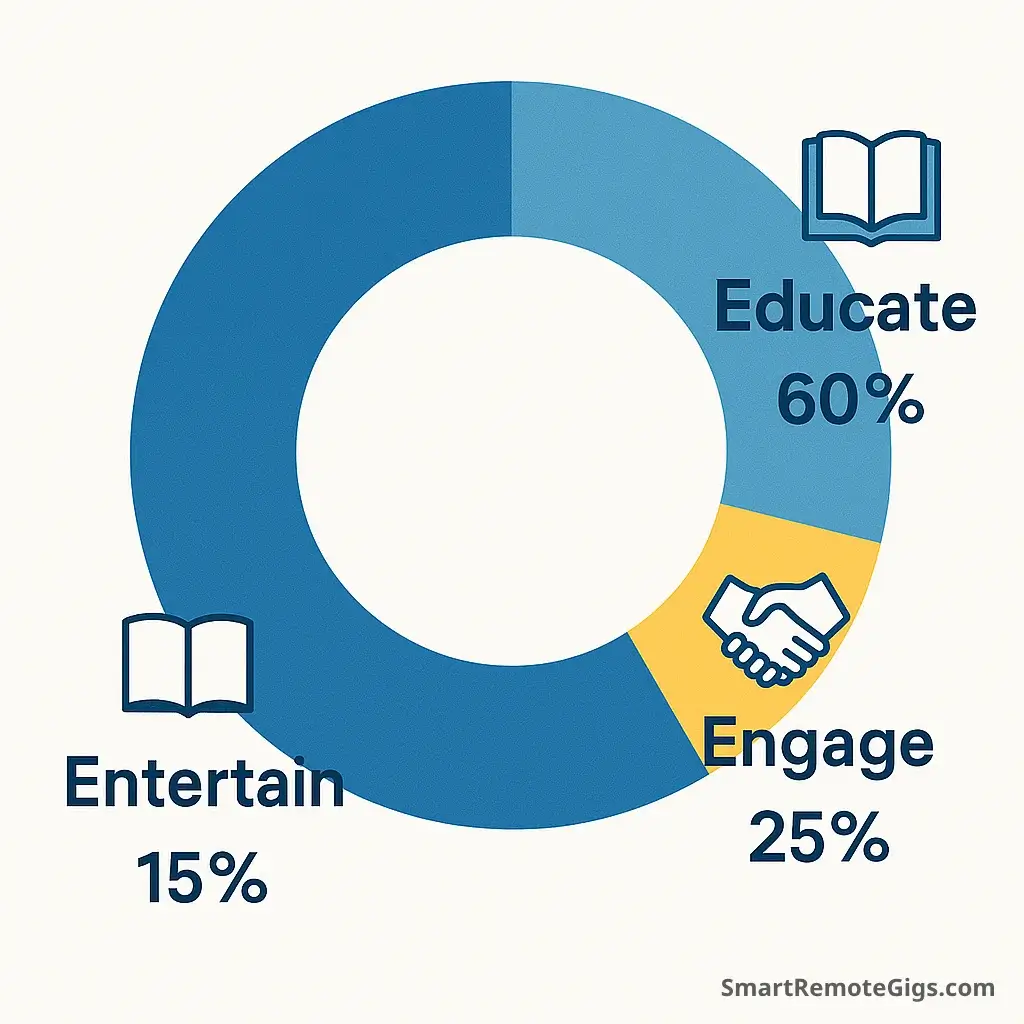
Once you have your content pillars established, you need a system for creating varied, engaging content within each pillar. This is where the 3-E Formula becomes your secret weapon: every piece of content should either Educate, Engage, or Entertain your audience.
Educate: Share Knowledge and Expertise
Educational content is the backbone of thought leadership content. It positions you as an expert while providing genuine value to your audience. This type of content answers questions, solves problems, and helps people learn something new.
Educational Content Examples:
- How-to tutorials that walk through complex processes step-by-step
- Best practices guides that share proven methodologies
- Tool comparisons that help people make informed decisions
- Case studies that demonstrate real-world applications
- Industry analysis that breaks down complex trends
Educational Content Template:
- Identify a common problem your audience faces
- Provide a clear solution with actionable steps
- Include specific examples or real-world applications
- End with a takeaway or next step
Engage: Spark Conversations and Build Community
Engaging content focuses on building relationships and fostering community around your brand. It encourages interaction, feedback, and meaningful discussions that strengthen your network.
Engaging Content Examples:
- Question posts that ask for opinions or experiences
- Polls and surveys that gather community insights
- Controversial takes (respectfully presented) that spark debate
- Community spotlights that celebrate others’ achievements
- Behind-the-scenes content that humanizes your professional journey
Engagement Strategies:
- Ask specific questions that require thoughtful responses
- Share vulnerable moments that invite others to relate
- Celebrate others’ successes and tag them in your posts
- Respond promptly and meaningfully to comments
- Create content that people want to share with their networks
Entertain: Add Personality and Humor
Entertainment doesn’t mean becoming a comedian—it means adding personality, relatability, and occasional humor to your professional content. This approach makes you more memorable and helps people connect with you on a human level.
Entertainment Content Examples:
- Industry memes that capture shared experiences
- Funny observations about professional life
- Personal anecdotes with humor and lessons learned
- Pop culture references tied to professional insights
- Self-deprecating stories that show humility and relatability
Entertainment Guidelines:
- Keep humor professional and inclusive
- Use entertainment to reinforce your expertise, not replace it
- Share personal stories that connect to professional lessons
- Be authentic—forced humor falls flat
- Test your content with trusted colleagues before posting
The 3-E Content Mix
For optimal engagement and growth, aim for this content distribution:
- 60% Educational (establishes expertise and provides value)
- 25% Engaging (builds community and relationships)
- 15% Entertaining (adds personality and memorability)
This mix ensures you’re providing consistent value while building meaningful relationships and showcasing your personality.
Step 3: Master the Art of Repurposing
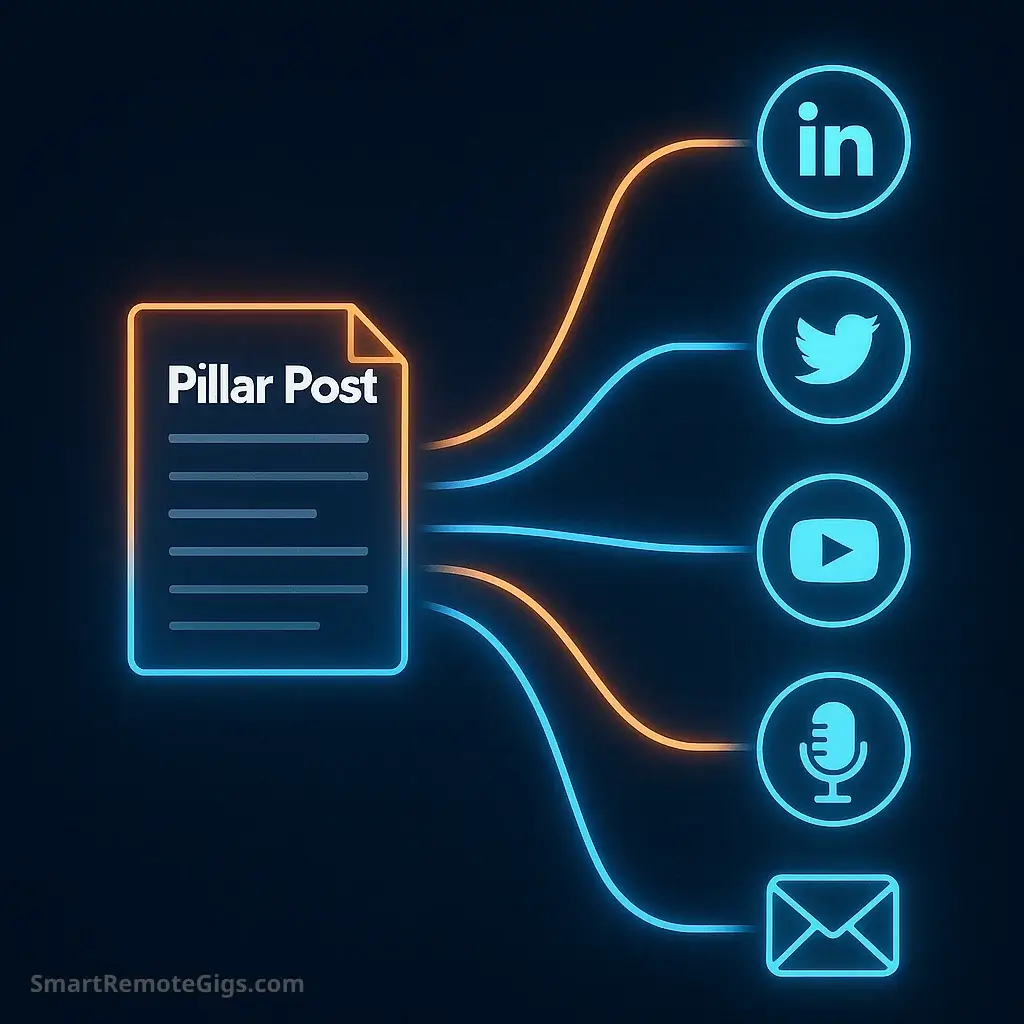
The secret to consistent content creation without burnout? Repurposing. One well-researched piece of content can become 5-10 different posts across multiple platforms, maximizing your time investment while reaching different segments of your audience.
The Content Multiplication Strategy
Here’s how to turn one blog post into a week’s worth of content ideas personal brand material:
Original Content: A 1,500-word blog post about “Remote Team Management Best Practices”
Repurposed Content:
- LinkedIn Article: Full blog post with professional insights
- Twitter Thread: 8-tweet summary of key points
- Instagram Carousel: Visual slides highlighting main tips
- YouTube Video: 10-minute walkthrough with examples
- Podcast Episode: Extended discussion with personal stories
- Email Newsletter: Condensed version with exclusive tips
- LinkedIn Posts: Individual posts for each major point (5-7 posts)
Repurposing Framework
Step 1: Create Pillar Content Start with substantial, well-researched content like blog posts, comprehensive guides, or detailed case studies. This becomes your “pillar content” that supports multiple smaller pieces.
Step 2: Extract Key Messages Break down your pillar content into individual insights, tips, quotes, statistics, or actionable steps. Each of these becomes a potential social media post.
Step 3: Adapt for Different Platforms Transform your key messages to fit different platform formats and audiences:
Platform | Format | Optimal Length | Key Features |
|---|---|---|---|
Professional posts, articles | 150-300 words | Industry insights, career advice | |
Threads, quick tips | 280 characters | Bite-sized wisdom, trending topics | |
Visual stories, carousels | Visual + captions | Behind-the-scenes, personal brand | |
YouTube | Educational videos | 5-15 minutes | In-depth tutorials, personality |
Newsletter content | 200-500 words | Exclusive insights, personal touch |
Step 4: Schedule and Space Out Don’t post all repurposed content at once. Space it out over days or weeks to maximize reach and avoid overwhelming your audience.
Step 5: Track and Optimize Monitor which repurposed formats perform best with your audience and adjust your strategy accordingly.
Content Recycling Strategy
Beyond repurposing new content, you can also recycle your best-performing posts:
- Quarterly reshares of evergreen content with updated insights
- Annual retrospectives of your top posts with new commentary
- Seasonal variations of popular content tied to current events
- Updated versions of older posts with new data or examples
This approach ensures your best content continues working for you long after its initial publication.
Step 4: Create a Sustainable Content Calendar
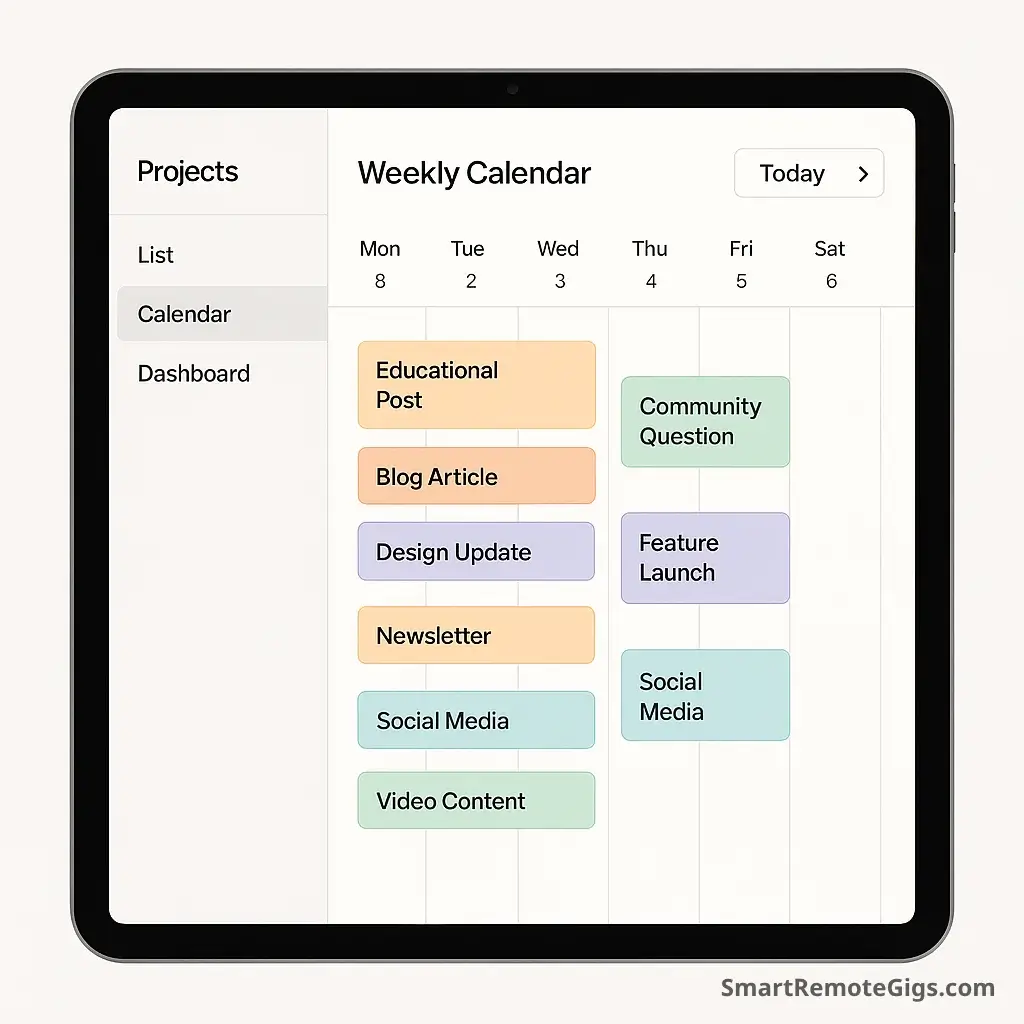
Consistency beats perfection in content creation, but consistency requires planning. A well-structured content calendar transforms sporadic posting into strategic, sustainable content creation that supports your personal brand content strategy.
The Simple Content Calendar Framework
You don’t need complex tools or elaborate systems. Start with this simple weekly framework:
Monday: Educational content (industry insights, tutorials) Tuesday: Personal journey/behind-the-scenes content Wednesday: Community engagement (questions, polls, discussions) Thursday: Thought leadership (opinions, predictions, analysis) Friday: Week wrap-up or lighter/entertaining content
Monthly Planning Process
Week 1 of Each Month: Planning Week
- Review previous month’s content performance
- Identify trending topics in your industry
- Plan content pillars focus for the month
- Create content themes for each week
Week 2-4: Content Creation and Posting
- Batch create content during designated time blocks
- Use scheduling tools to maintain consistency
- Engage actively with your audience’s responses
- Monitor performance and adjust strategy as needed
Content Calendar Template
Here’s a simple monthly template to get you started:
Week | Pillar Focus | Monday | Tuesday | Wednesday | Thursday | Friday |
|---|---|---|---|---|---|---|
Week 1 | Technical Skills | Tutorial post | Learning journey | Industry discussion | Tool comparison | Week highlights |
Week 2 | Career Growth | Skill-building tip | Career milestone | Network question | Industry trend | Personal insight |
Week 3 | Remote Work | Productivity hack | Workspace tour | Team collaboration | Future of work | Work-life balance |
Week 4 | Industry Insights | Market analysis | Personal opinion | Community poll | Prediction post | Month recap |
Batch Content Creation
Dedicate specific time blocks for content creation rather than trying to create content daily:
Weekly Batch Session (2-3 hours):
- Create 5-7 posts for the upcoming week
- Schedule posts using tools like Buffer or Hootsuite
- Prepare engaging visuals or graphics
- Draft responses to potential comments
Monthly Batch Session (4-6 hours):
- Create pillar content (blog posts, detailed guides)
- Plan content themes for the month
- Research trending topics and industry news
- Update and optimize older content
Content Calendar Tools
Free Options:
- Google Sheets: Simple, shareable, customizable
- Trello: Visual board system with due dates
- Notion: All-in-one workspace with templates
Paid Options:
- Buffer: Scheduling with analytics
- Hootsuite: Multi-platform management
- Later: Visual content calendar with analytics
Flexibility Within Structure
While consistency is important, your content calendar should be flexible enough to accommodate:
- Breaking news or trending topics in your industry
- Personal milestones or achievements worth sharing
- Seasonal content tied to holidays or industry events
- Collaborative opportunities with others in your network
- Spontaneous insights that deserve immediate sharing
Remember: Your content calendar is a guide, not a rigid rule. The goal is to maintain consistency while staying responsive to opportunities and authentic to your voice.
Pro Tip: Connect Your Content to Your Network
Creating great content is only half the battle. The most powerful distribution channel you have isn’t a tool—it’s your professional network. Every article you write and every insight you share is a valuable opportunity to start conversations and strengthen relationships.However, sharing effectively requires more than just hitting “publish.” To master the art of using your content to build genuine connections, not just chase clicks, you need a robust networking strategy.
For a complete system on how to do this, explore our comprehensive A Guide to Virtual Networking for Your Remote Career Success.
Bonus: 15 Content Ideas You Can Steal Today
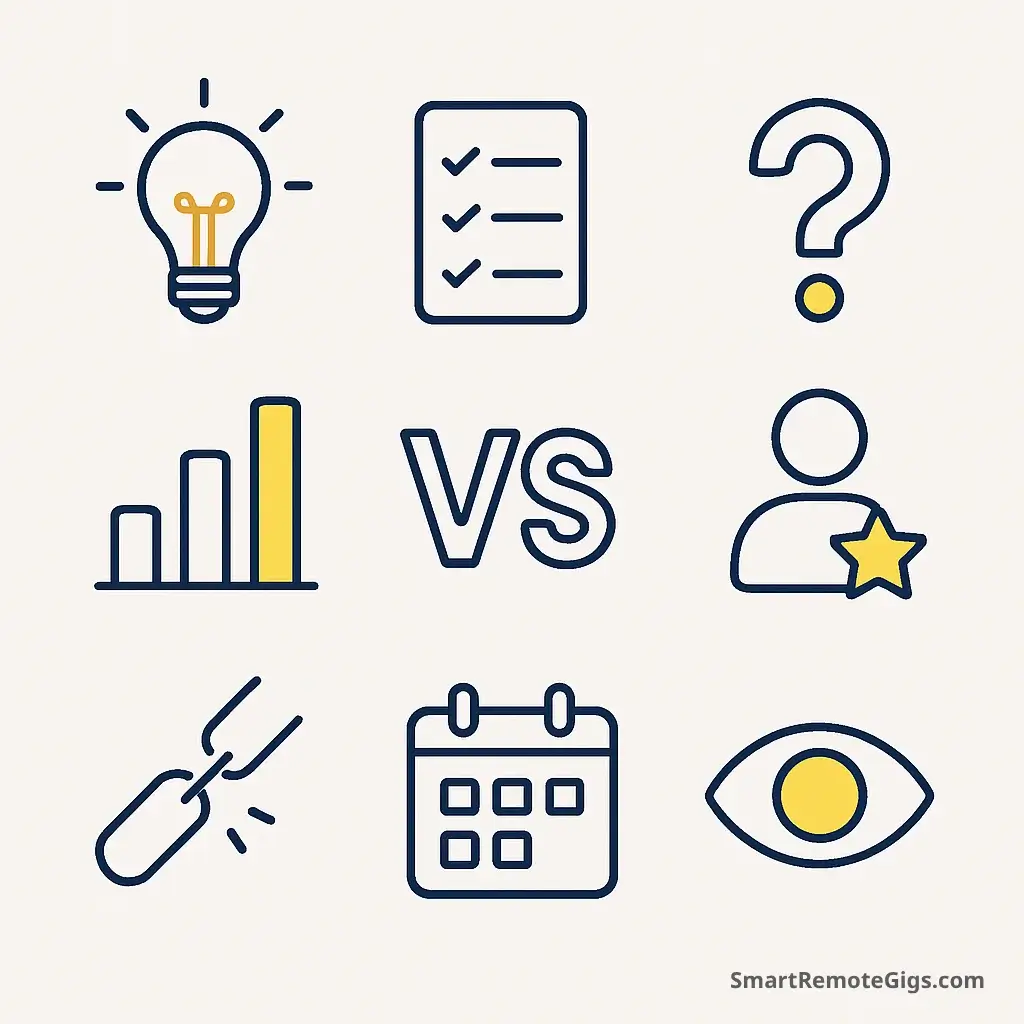
Sometimes you need immediate inspiration. Here are 15 proven content ideas personal brand that work across industries and can be adapted to any content pillars strategy:
Educational Content Ideas
1. “The 5-Minute Fix” Share a quick solution to a common problem in your industry. Format: “How to [solve specific problem] in under 5 minutes.”
2. “Tool Comparison” Compare 2-3 tools your audience uses regularly. Include pros, cons, and your recommendation with reasoning.
3. “Beginner’s Mistake” Share a common mistake newcomers make in your field and how to avoid it. Include your own experience if relevant.
4. “Step-by-Step Process” Break down a complex process into simple, actionable steps. Use numbered lists for easy consumption.
5. “Industry Terminology Decoded” Explain confusing jargon or acronyms in your field in plain language.
Engaging Content Ideas
6. “Unpopular Opinion” Share a respectful contrarian view about a common practice in your industry. Ask for others’ thoughts.
7. “This or That” Create a poll comparing two options (tools, strategies, approaches) and ask your audience to vote and explain their choice.
8. “Community Spotlight” Highlight someone in your network who’s done excellent work. Tag them and explain why they deserve recognition.
9. “Ask Me Anything” Invite your audience to ask questions about your expertise area. Answer the best ones in follow-up posts.
10. “Fill in the Blank” Start a sentence related to your industry and ask others to complete it. Example: “The biggest challenge in remote work is ______.”
Personal Journey Content Ideas
11. “Failure Friday” Share a professional failure, what you learned from it, and how it shaped your approach.
12. “Behind the Scenes” Show your workspace, daily routine, or the unglamorous reality behind your professional success.
13. “Learning in Public” Share something new you’re learning, including struggles and progress. This shows humility and growth mindset.
14. “Career Pivot Story” Explain a significant change in your career path and what motivated the decision.
15. “Gratitude Post” Thank someone who helped you professionally. Explain their impact and why you’re grateful.
Content Adaptation Template
For each idea, use this template to create engaging posts:
Hook: Start with an attention-grabbing statement or question Context: Provide background or setup for your main point Value: Share the insight, tip, or lesson Action: Give readers something specific to do or think about Engagement: End with a question or call for comments
Example Post Using Idea #3:
Hook: “I’ve seen this mistake cost developers months of progress…”
Context: “When I started coding, I thought commenting was for beginners. ‘Good code documents itself,’ I told myself.”
Value: “Six months later, I couldn’t understand my own code. I learned that comments aren’t about explaining WHAT your code does—they’re about explaining WHY you made certain decisions.”
Action: “Now I comment every non-obvious decision. Future me (and my teammates) thank me constantly.”
Engagement: “What’s the biggest coding mistake you made early in your career? Drop it in the comments—let’s help others avoid our pain!”
These 15 ideas provide immediate inspiration while teaching you the underlying patterns of effective content creation. Adapt them to your content pillars and industry for maximum impact.
Transform Your Content Strategy Today
Creating consistent, engaging content doesn’t require marketing genius or endless creativity—it requires a simple, proven framework. By defining your content pillars, applying the 3-E formula, mastering repurposing, and maintaining a sustainable calendar, you’ve eliminated the guesswork that keeps most professionals stuck in content creation limbo.
Remember: Consistency beats perfection every single time. Your audience would rather read one helpful post per week for a year than ten brilliant posts in a month followed by silence. The framework you’ve learned today is designed for sustainability, not burnout.
The most successful professionals understand that thought leadership content isn’t about being the smartest person in the room—it’s about being the most helpful. When you consistently provide value, share insights, and engage authentically with your community, opportunities naturally follow.
Your personal brand content strategy is now equipped with everything needed for long-term success. The only thing left is to start implementing. Choose your content pillars, plan your first week of content, and begin building the professional reputation you deserve.
Ready to integrate this content strategy into a comprehensive personal branding approach? This framework is just one piece of building a powerful professional presence. For the complete system that covers networking, positioning, thought leadership, and career acceleration, dive into our comprehensive Remote Personal Branding Playbook Guide and discover how successful professionals build unshakeable personal brands in today’s competitive market.
Your audience is waiting for your unique voice and valuable insights. Stop letting the blank page win—start creating content that advances your career and serves your community.
Quick Implementation Checklist:
Begin with just 2-3 items from this checklist today. Small, consistent actions compound into remarkable results over time.




